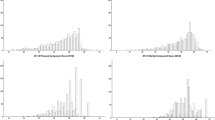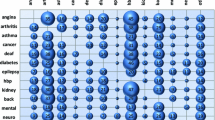Abstract
Objectives: To compare the performance of the RAND-12 and SF-12 physical and mental health summary scores, in a sample of people with type 2 diabetes, in distinguishing groups of differing disease severity. Methods: Summary scores from RAND-12 and SF-12 were compared between known subgroups defined in terms of treatment intensity, duration of diabetes, time lost from work and emergency room visits for diabetes. Multiple regression analyses were used to compare known groups. Results: Statistically significant and clinically important differences were observed across comparisons of the RAND-12 physical health composite (PHC), that were not apparent on the physical component score (PCS-12). RAND-12 mental health composite (MHC) scores were statistically significant according to treatment intensity and days off work due to diabetes, but differences in mental component score (MCS-12) scores failed to reach statistical significance for any of these comparisons. Conclusion: Interpretation of the SF-12 summary scores in our study would have overlooked seemingly important differences in health that were picked up by the RAND-12 summary scores.
Similar content being viewed by others
References
Ware JE, Kosinski M, Keller SD. A 12-time short form health survey: Construction of scales and preliminary tests of reliability and validity. Med Care 1996; 34: 220-233.
Hays RD. RAND-36 Health Status Inventory. San Antonio: The Psychological Corporation, 1998.
Nordvedt MW, Riise T, Mohr K-M, Nyland HI. Performance of the SF-36, SF-12, and RAND-36 summary scales in a multiple sclerosis population. Med Care 2000; 38: 1022-1028.
Birbeck GI, Kim S, Hays RD, Vickery BG. Quality of life measures in epilepsy: How well can they detect change over time? Neurology 2000; 54: 1822-1827.
Taft C, Karlsson J, Sullivan M. Do SF-36 summary component scores accurately summarize subscale scores? Qual Life Res 2001; 10: 395-404.
Taft C, Karlsson J, Sullivan M. Reply to Drs Ware and Kosinski. Qual Life Res 2001; 10: 415-420.
Ware JE, Kosinski M. Interpreting SF-36 summary health measures: A response. Qual Life Res 2001; 10: 405-413.
Simon GE, Revicki DA, Grothaus L, VonKorff M. SF-36 Summary scores: Are physical and mental health truly distinct? Med Care 1998; 36: 567-572.
Wilson D, Parsons J, Tucker G. The SF-36 summary scales: Problems and solutions. Soc Prev Med 2000; 45: 239-246.
Majumdar SR, Johnson JA, Guirguis LM, Lewanczuk RZ, Lee TK, Toth EL. A prospective controlled trial of an intervention to improve care for patients with diabetes in rural communities: Rationale and design for the DOVE study. Can J Diabetes Care 2001; 25: 173-179.
Meltzer S, Leiter L, Daneman D, et al. 1998 Clinical practice guidelines for the management of diabetes in Canada. CMAJ 1998; 159(suppl. 8): S1-S29.
Jacobson AM, Samson JA, deGroot M. The evaluation of two measures of quality of life in patients with type I and II diabetes. Diabetes Care 1994; 17: 267-274.
Keinanenn-Kiukaanniemi S, Ohinmaa A, Pjunpaa H, Koivukangas P. Health related quality of life in diabetic patients measured by the Nottingham Health Profile. Diabetic Med 1996; 13: 382-388.
Glasgow RE, Ruggiero L, Eakin EG, Dryfoos J, Chobanian L. Quality of life and associated characteristics in a large national sample of adults with diabetes. Diabetes Care 1997; 20: 562-567.
Peterson T, Lee P, Young B, Dornan T. Well-being and treatment satisfaction in older people with diabetes. Diabetes Care 1998; 21: 930-935.
Glasgow RE, Ruggiero L, Eakin EG, Dryfoos J, Chobanian L. Quality of life and associated characteristics in a large national sample of adults with diabetes. Diabetes Care 1997; 20: 562-567.
Klein BE, Klein R, Moss SE. Self-rated health and diabetes of long duration. The Wisconsin epidemiologic study of diabetic retinopathy. Diabetes Care 1998; 21: 236-240.
Peyrot M, Rubin RR. Levels and risks of depression and anxiety symptomology among diabetic adults. Diabetes Care 1997; 20: 585-590.
Weinberger M, Kirkman MS, Samsa GP, et al. The relationship between glycemic control and health-related quality of life in patients with non-insulin dependent diabetes mellitus. Med Care 1994; 29: 1173-1181.
Hirsch A, Bartholomae C, Volmer T. Dimensions of quality of life in people with non-insulin dependent diabetes. Qual Life Res 2000; 9: 207-218.
Woodcock AJ, Julious SA, Kinmouth AL, Campbell MJ. Problems with the performance of the SF-36 among people with type 2 diabetes in general practice. Qual Life Res 2001; 10: 661-670.
Author information
Authors and Affiliations
Rights and permissions
About this article
Cite this article
Johnson, J.A., Maddigan, S.L. Performance of the RAND-12 and SF-12 summary scores in type 2 diabetes. Qual Life Res 13, 449–456 (2004). https://doi.org/10.1023/B:QURE.0000018494.72748.cf
Issue Date:
DOI: https://doi.org/10.1023/B:QURE.0000018494.72748.cf




